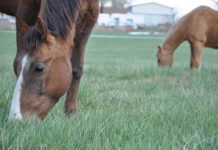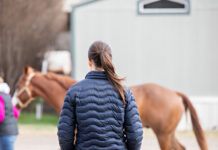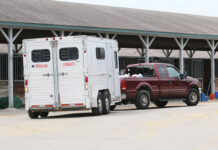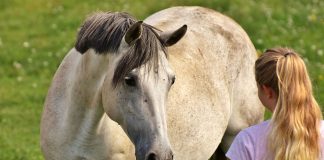It’s summertime—there’s more time to ride and more time to spend outside with your horse. Unfortunately, the warm weather also means more time for flies to start reproducing. Flies will soon be tormenting your horse, if they aren’t already. But all is not lost; you can fight back. The following 10 methods of fly control go a long way toward keeping fly populations under control.
1. Manure Management
The best way to keep these fly numbers down is to frequently remove manure from your horse’s stall or paddock. Barn aisles, turnout areas and riding arenas should also be cleaned. Clean at least once a day; more often if you can.
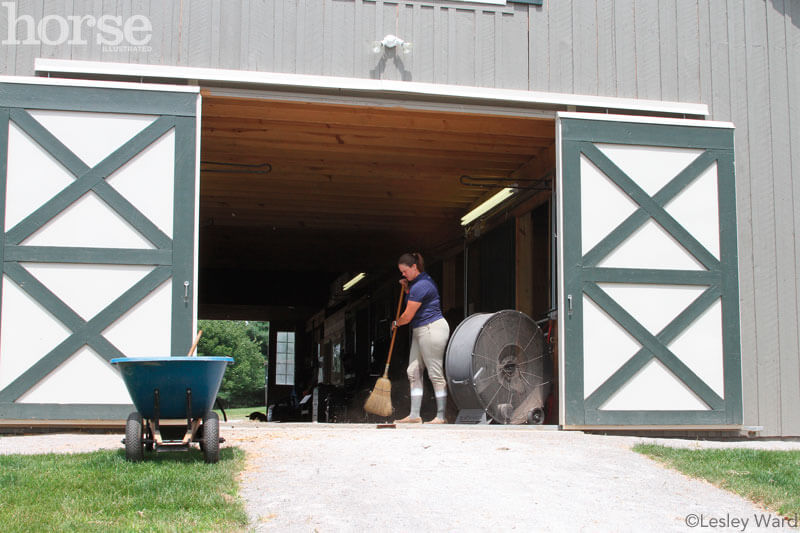
Once manure is scooped up, it should be taken to a manure pile far away from the barn or stored in a covered dumpster until you can remove it from your property.
Soiled bedding is another favorite spot for flies to lay their eggs. Remove wet shavings or straw from your horse’s stall every day to keep the fly population down.
2. Moisture Control
Flies love moisture and seek out wet areas to breed. Search your property for leaks from faucets, sprinklers and pipes. Look for areas where rain water gathers, too.
If your horse has a favorite spot in his stall or paddock to urinate, you can bet that flies are laying their eggs there. Put down moisture-absorbing materials to help soak up the urine. In box stalls, keep urine to a minimum with frequent cleanings and by using highly absorbent bedding.
3. Biological Controls
An eco-friendly way to combat flies is to use biological methods. Tiny parasitic wasps are widely available, and work by destroying the fly larvae before it can hatch. Signing up for a monthly delivery of these predatory insects during fly season can help keep the fly population down at your barn.
Harmless to humans and so small you can barely see them, the wasps are shipped still in the egg stage. Once a few of the wasps hatch in the plastic bag after delivery, you sprinkle the contents in and around your horse’s living area.
4. Traps
Available in a variety of different types, fly traps work by attracting flies, either through color or scent. Once the fly lands on or enters the trap, it can’t escape and eventually dies.
The simplest type of fly trap uses a sticky surface to capture flies. The flies are drawn to the color—usually orange or yellow—and land on it. The glue-covered surface sticks to their feet, keeping them from flying away. Other traps use bait to lure the fly inside. Some traps have water inside, and the flies drown because they can’t escape. Others simply trap them inside the container, where they die due to lack of food and water.
Sticky fly traps can be hung anywhere flies congregate, but should be safely out of reach of curious horses. Baited traps should be placed far from stalls since they will initially attract more flies to the area before the insects become trapped.
5. Barn fans
Flies tend to be less active when there’s a strong breeze, as wind affects their ability to fly. So create your own wind! Barn fans hung from the ceiling over each stall and in the barn aisles can do wonders for keeping flies out of the area. Freestanding fans can also be used in barn aisles.
6. Stable Management
The environment surrounding your horses can have a big effect on the number of flies at your facility. Practicing good barn keeping will keep flies to a minimum.
Start by making sure all garbage cans are securely covered. An open trash can will draw flies from near and far. Keep feed storage containers covered as well since some grains and sweet feeds can attract flies. Clean up spilled feed right away, especially if it’s wet.
Be sure to dispose of any rotting hay on the property since this is the perfect breeding environment for flies. The combination of moisture and organic material is a haven for these pests. Also, avoid using straw as bedding since wet straw is a magnet for flies.
7. Fly Sprays
Both insecticidal sprays and repellents discourage flies from landing on your horse.
Oil-based sprays have more staying power than water-based products, and both are best used in conjunction with other types of fly control. They should not be used in the vicinity of parasitoid wasps, however, since the beneficial insects are also susceptible to insecticides.
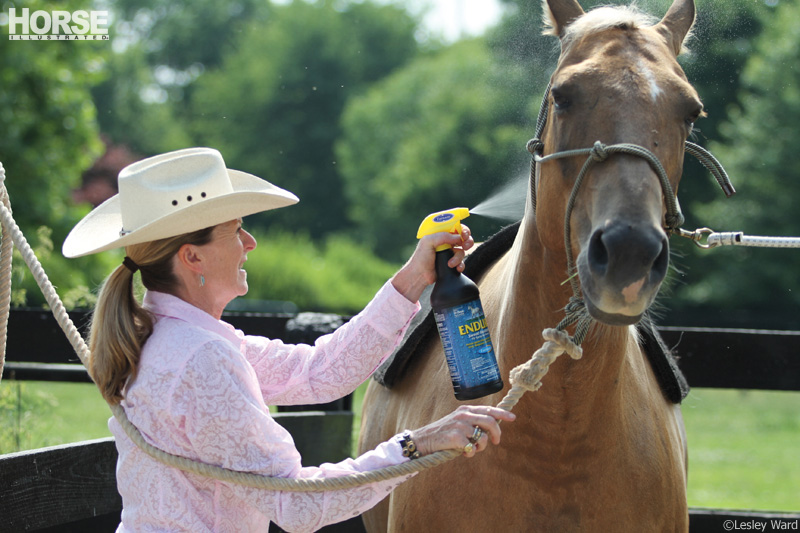
When applying fly sprays, be sure to use an adequate amount as directed on the label. If you don’t coat the horse’s hair with the spray, flies can still land and bite. For applying around the eyes, ears and muzzle, spray the product onto a washcloth and wipe it onto the horse’s face. You can also use a roll-on insecticide for these delicate areas.
8. Cover-Ups
No matter how good your fly control methods, it’s impossible to get rid of every single fly. To protect your horse from these biting pests, use cover-ups.
Fly masks are the most effective way to protect your horse from flies. Face flies are notorious for feeding on the mucus in your horse’s eyes, causing irritation and potentially spreading disease. You can also use a mask with attached ear covers to keep biting gnats out of his ears.
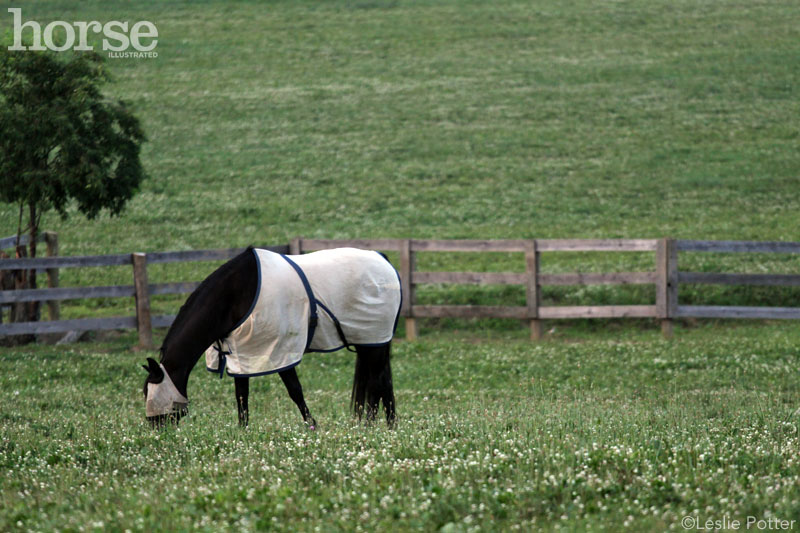
A fly sheet prevents flies from landing directly on your horse’s body. The lightweight mesh blanket protects your horse’s chest, back, sides and hindquarters from biting flies. Add mesh leg wraps to protect the lower legs, and flies will have a hard time finding a place to bite your horse.
By using these methods, you can make a big impact on the number of flies that live on your property and pester your horses.
9. Spray systems
In a barn environment, an overhead fly spray system can be effective at keeping fly populations down. Spray systems release a repellent or insecticidal mist periodically throughout the day. The spray comes down onto the horses and prevents flies from landing and biting. The system can be designed to spray directly into both stalls and barn aisles.
After installing a spray system in your barn, choose the type of insecticide or repellent you want to use. If you are concerned about introducing chemical fly products into the environment, opt for natural formulations.
10. Supplements
Supplements designed to prevent flies from breeding in manure or to discourage flies from biting are another option for your horse. Insect growth regulators (IGR) are chemicals that disrupt the fly’s ability to reproduce by affecting the pupa stage in the life cycle. When the active ingredient in the IGR is present in the horse’s manure, the fly larvae can’t develop to adulthood.
A feed-through product containing an IGR is added daily to the horse’s food, and then passes through the horse and is deposited with the manure. The IGR has no effect on the horse, but wreaks havoc on the fly population.
Natural supplement formulas containing garlic, apple cider, yeast and other ingredients with natural fly-repelling properties are reported to discourage flies from biting. These products must be fed daily to be effective.
This article originally appeared in the July 2015 issue of Horse Illustrated magazine. Click here to subscribe!

